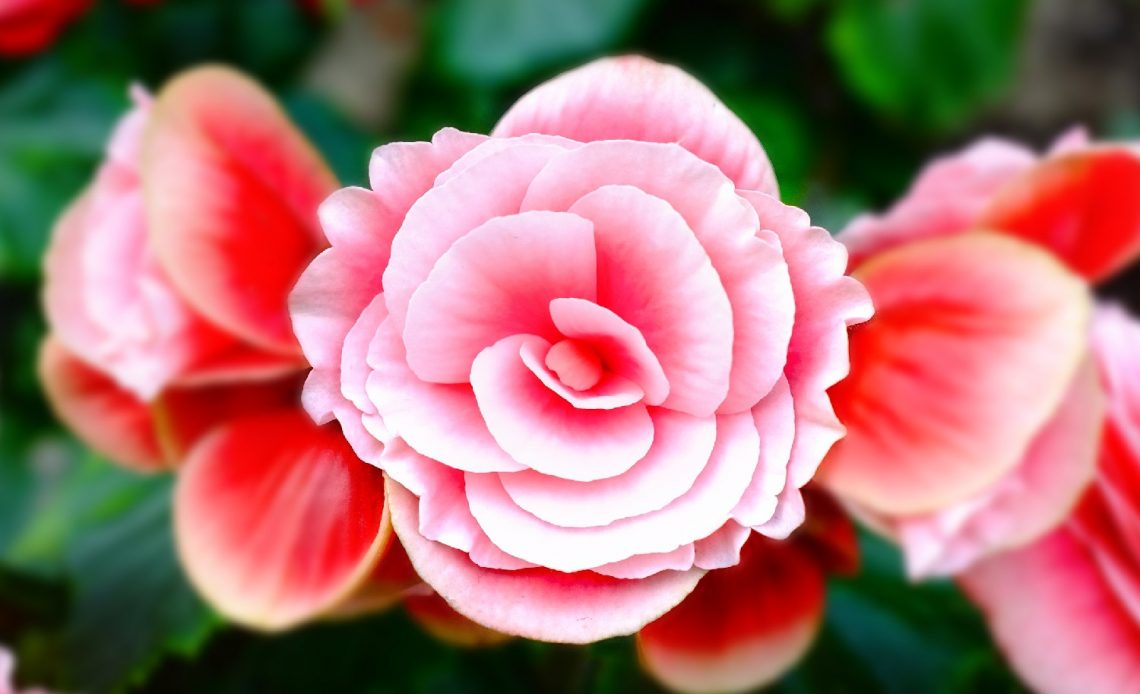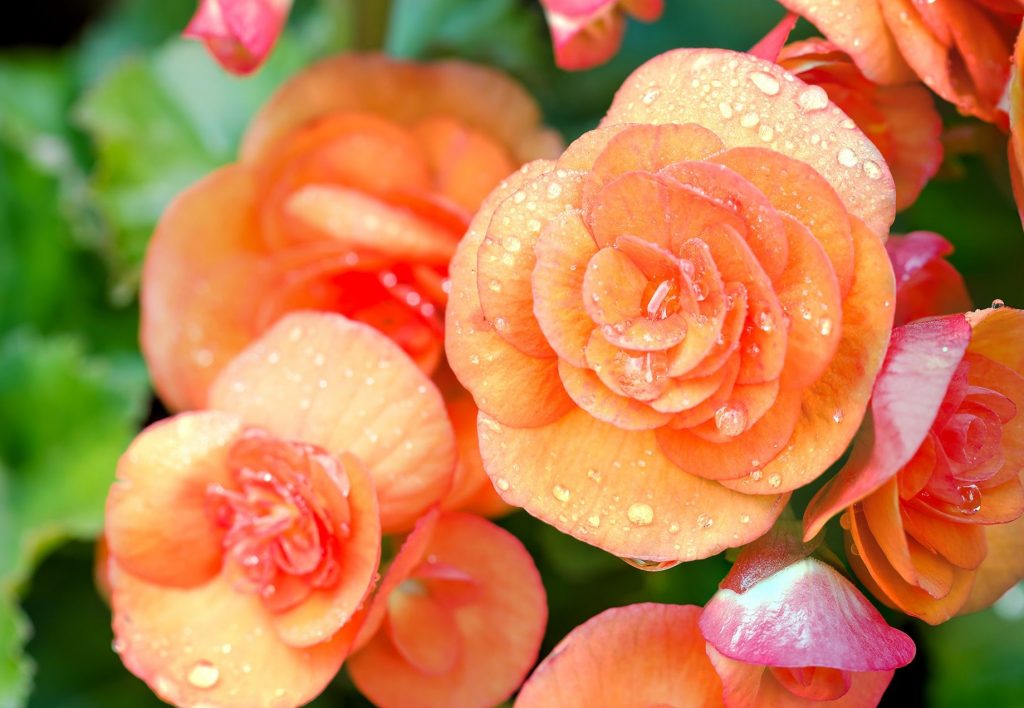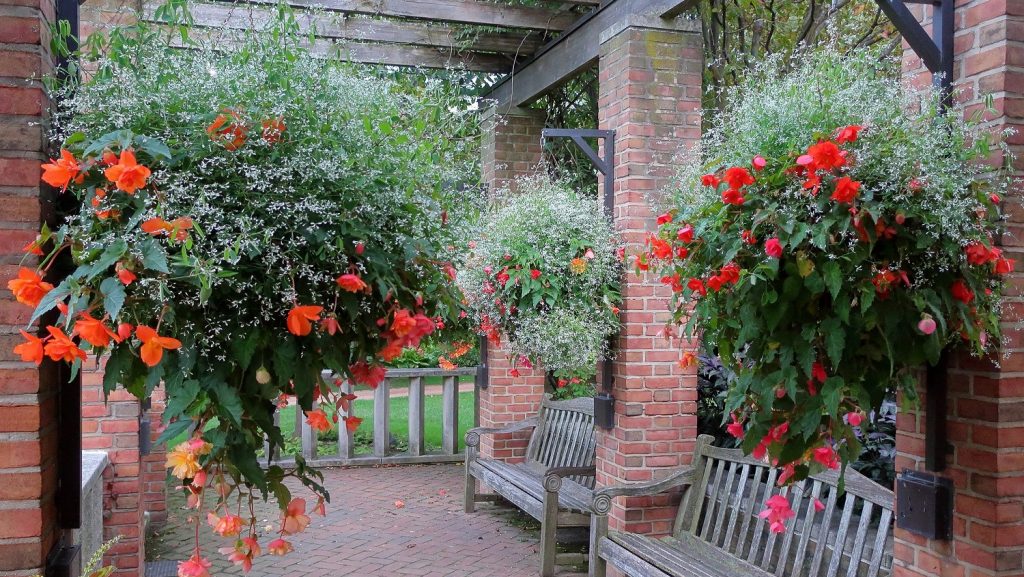

We’re here to help! Wild Yards is a completely free website that is 100% dedicated to helping you create a wildlife-friendly, sustainable yard. Read more
WildYards is reader-supported. When you buy a product through a link on our site, we may earn a comission. Every product is independently selected by our (obsessive) editors and our reviews are unbiased and objective. Read more about our mission or our privacy policy.
Begonias are lovely little flowers that look just right in a window box or decorative pot. These popular ornamentals make for wonderful accent plants and can be used to attract all sorts of wildlife to your garden. Bees and butterflies will both happily visit these delicate flowers at every opportunity. But what about other pollinators? Do hummingbirds like begonias, too?
Hummingbirds are very attracted to begonias. These shade-loving plants can be grown in almost every location across the U.S. With over 2,000 varieties to choose from, you’re sure to find a begonia that makes you and your hummingbirds happy!
Do hummingbirds like begonias because they produce a lot of nectar?
Hummingbirds rely on insects and nectar to meet their nutritional needs. These little fellas weigh a measly four grams or 0.009 pounds. That’s less than a nickel or two pennies. And because they’re so incredibly fast, their metabolisms are constantly revved up. A hummingbird’s metabolic rate is 100 times faster than an elephant’s.
These impressive little birds have the fastest metabolisms relative to their size of any vertebrate. So it comes as no surprise that hummingbirds need to eat a lot of food to keep up with their energy demand. As a result, they rely heavily on flowers with lots of nectar just to survive.
Ironically, for as much as hummingbirds love begonias, these flowers don’t produce that much nectar. Some begonias may produce greater quantities due to things like nutrient availability, climate, seasonal conditions, and variety. But by and large, these are ornamental flowers meant to dress up a landscape, not feed the local wildlife.
Most of today’s begonias have been cultivated to bloom repeatedly. Usually, these plants are completely sterile. Since they don’t need to be pollinated, they don’t have to produce the nectar and pollen that pollinators like to feed on.
Many of the showier cultivars have the ability to attract hummingbirds, bees, and butterflies. But they don’t have the resources these animals and insects need to survive. So even though hummingbirds will be drawn to your begonias initially, once they realize these flowers are empty, they’ll turn right around and go find someplace else to feed.
Why do hummingbirds like begonias if they aren’t a good source of nectar?
Hummingbirds are drawn to fragrant, brightly-colored flowers and that’s a begonia in a nutshell. Because hummingbirds move around so quickly, it can be tough for them to spot some flowers. The begonia’s varying shades of pink, purple, red, orange, and yellow blossoms are easy for these fast-flying birds to see from midair. Some begonias are even flashier with eye-catching double blooms.
Additionally, begonias give off a delightful scent that hummingbirds are extremely attracted to. Typically, that strong aroma is an indicator that a flower is full of nectar. In the begonia’s case, that smell is a false positive. But it’s enough to draw a hummingbird’s attention, nevertheless.
Hummingbirds also tend to check out plants that other pollinators congregate around. Bees, butterflies, and other insects also enjoy visiting begonias. Since this plant can be such a high-traffic area in a garden, it’s more likely to grab a hungry hummingbird’s attention.
If you have begonias planted in your yard, don’t be surprised to see these ferocious avians duking it out with wasps, bees, and even each other. Their delicate appearance belies their aggressive nature. These tiny birds are incredibly territorial, and they will guard resources that they’ve deemed valuable like nobody’s business. Sheesh, it’s a good thing hummingbirds aren’t any bigger than they are. Otherwise, we’d all be in trouble!
Which varieties of begonias do hummingbirds like best?
Begonias can be planted in zones 2 through 11. They’re easy to grow, blooming throughout the summer when placed in a nice, shady spot. But because they don’t like the cold, most begonias die back in the winter, so many gardeners consider them to be annuals.
Begonias are big enough to make their presence known but small enough to be easy to manage. At their tallest, begonias grow to heights of about one foot. The flowers are fairly sizable, with flower heads averaging about four inches in diameter. This is a classic-looking flower that’s simple to grow, making it a popular choice among amateur and master gardeners alike.
Hummingbirds are generally pretty happy to visit any begonias. So feel free to choose whichever ones you like best. However, hummingbirds do prefer begonias in shades of yellow, orange, and red. Additionally, thanks to their strong sense of smell, they’re more likely to select the most fragrant varieties — of which there are many!
‘Pin Up Flame’ begonias are gorgeous bright red and orange blooms that fade to yellow and white hues towards the center. Hummingbirds adore their coloring, as well as their pleasant aroma. ‘Surefire’ begonias produce dozens of small, deliciously-scented red flowers and grow very well in full to partial shade, where hummingbirds like to stay during the sunniest part of the day. Planting these two varieties together makes a great focal point in a shady yard.

Nearly any begonia that is advertised as being “fragrant” will be a safe bet for your hummingbird garden. ‘Fragrant Falls’ and ‘Pink Delight’ are two varieties that are popular among gardeners for their smell. With cascading blossoms, they look amazing in hanging baskets, and will bring hummingbirds right up to your home when you hang them from your porch!
If you’re just beginning to test the waters with begonias, give a begonia mix a shot. These samplers feature a variety of begonias of different colors that will allow you to decide which ones you prefer. They will also give you a chance to observe which begonias your neighborhood hummingbirds like to visit the most.
How can you use begonias to attract more hummingbirds to your garden?
Begonias make beautiful accent plants and can be grown as a border around an existing flower bed to great effect. But these plants are just as attractive in hanging baskets and window boxes. Wherever you decide to plant them, your begonias are sure to attract the hummingbirds. Just be careful not to place them too close to your doorways. It’s all fun and games until one of them flies inside your house!
The wonderful thing about these plants is that they thrive in the shade. This makes them an excellent choice for anyone who lives in a wooded area. If you have a shady patch in your yard, you know how difficult it can be to get anything to grow there. You’re probably also well aware of how difficult it is to attract hummingbirds without any flowers. If you’re at your wit’s end trying to find plants that bloom in the shade, begonias could very well be your solution.
Just remember, while begonias are fragrant and colorful, they don’t produce a ton of nectar. This is the biggest drawback of flowers that have been cultivated for their looks. The more hybridized a plant becomes, the less nectar and pollen they create.
Of course, just because begonias don’t produce much nectar doesn’t mean that they can’t play a valuable role in your hummingbird garden. Their high visibility as well as their strong perfume consistently makes these flowers a hit with hummingbirds. Just be sure to plant plenty of other nectar-rich flowers alongside your begonias, and you’re sure to keep your hummingbirds interested in your yard for a long time to come.

Which flowers should you plant with your begonias to attract hummingbirds?
Not all nectar tastes the same, you know. Each flower produces a nectar that is unique to itself. That’s why hummingbirds enjoy perusing different blooms. They can get a little taste of everything. They like variety! So if you want your flower garden to be a hit with hummingbirds, give them what they want. Plant lots of different hummingbird-friendly plants together to maximize your success.
Wisteria is a gorgeous vine that produces multiple purple flowers. Each blossom is loaded with nectar that hummingbirds, butterflies, and bees all adore. This is one of the best plants to add to your backyard if you want to attract pollinators. And the older the plant gets, the more blooms it produces, so it only gets better over time.
Hummingbirds also enjoy all manner of lilies. Daylilies are a popular choice among hummingbirds in the South. In other parts of the United States, Canada lilies and Columbia lilies will do the trick.
Azaleas produce a multitude of pink, red, purple, and white flowers. These bushes are relatively fast-growing, and, like begonias, they do well in the shade. Even though azaleas are toxic to humans, the nectar they produce is perfectly safe for hummingbirds to enjoy — which they do immensely!
Other blooms that hummingbirds enjoy visiting include sunflowers, morning glory, and butterfly bush. These flowers produce adequate amounts of nectar that will provide your hummingbirds with the sustenance they need to survive. All the butterflies and the bees in your neighborhood will love visiting them, too. When planted together with your beloved begonias, you’ll have one gorgeous flower garden that pollinators of all varieties will find irresistible!
If you already have begonias and you just don’t have the space for more flowers, don’t despair. You can still have the best of both worlds. Place your begonias up in a hanging basket where hummingbirds are sure to see them and hang a hummingbird feeder nearby.
Just be sure to fill it with homemade hummingbird nectar, not the commercial stuff. The red dye used in store-bought hummingbird food isn’t too good for animals. Always use organic granular sugar when making nectar for pollinators. Brown sugar is difficult for most insects and animals to digest. You can also try setting out a small dish of grape jelly — the kind with real sugar, not the artificially sweetened stuff. That sugar rush is exactly what hummingbirds are looking for.
Begonias can definitely help you attract more hummingbirds to your yard, but they’re just not a good source of nectar. Fortunately, there’s no need to uproot them! With a few simple hacks, you can keep your begonias right where they are while supporting your region’s pollinators.
